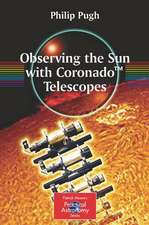Meteors and How to Observe Them: Astronomers' Observing Guides
Autor Robert Lunsforden Limba Engleză Paperback – 10 dec 2008
Din seria Astronomers' Observing Guides
-
 Preț: 183.23 lei
Preț: 183.23 lei -
 Preț: 196.41 lei
Preț: 196.41 lei -
 Preț: 189.37 lei
Preț: 189.37 lei -
 Preț: 193.12 lei
Preț: 193.12 lei -
 Preț: 184.28 lei
Preț: 184.28 lei -
 Preț: 329.89 lei
Preț: 329.89 lei -
 Preț: 273.58 lei
Preț: 273.58 lei -
 Preț: 275.79 lei
Preț: 275.79 lei -
 Preț: 280.19 lei
Preț: 280.19 lei -
 Preț: 254.46 lei
Preț: 254.46 lei -
 Preț: 251.37 lei
Preț: 251.37 lei -
 Preț: 285.68 lei
Preț: 285.68 lei -
 Preț: 213.79 lei
Preț: 213.79 lei -
 Preț: 254.90 lei
Preț: 254.90 lei -
 Preț: 298.02 lei
Preț: 298.02 lei -
 Preț: 217.51 lei
Preț: 217.51 lei -
 Preț: 300.37 lei
Preț: 300.37 lei -
 Preț: 345.09 lei
Preț: 345.09 lei -
 Preț: 342.13 lei
Preț: 342.13 lei -
 Preț: 246.30 lei
Preț: 246.30 lei -
 Preț: 256.78 lei
Preț: 256.78 lei -
 Preț: 210.90 lei
Preț: 210.90 lei
Preț: 270.70 lei
Nou
Puncte Express: 406
Preț estimativ în valută:
51.80€ • 54.08$ • 42.87£
51.80€ • 54.08$ • 42.87£
Carte tipărită la comandă
Livrare economică 31 martie-07 aprilie
Preluare comenzi: 021 569.72.76
Specificații
ISBN-13: 9780387094601
ISBN-10: 0387094601
Pagini: 192
Ilustrații: XV, 192 p. 151 illus.
Dimensiuni: 178 x 235 x 9 mm
Greutate: 0.4 kg
Ediția:2009
Editura: Springer
Colecția Springer
Seria Astronomers' Observing Guides
Locul publicării:New York, NY, United States
ISBN-10: 0387094601
Pagini: 192
Ilustrații: XV, 192 p. 151 illus.
Dimensiuni: 178 x 235 x 9 mm
Greutate: 0.4 kg
Ediția:2009
Editura: Springer
Colecția Springer
Seria Astronomers' Observing Guides
Locul publicării:New York, NY, United States
Public țintă
Popular/generalCuprins
An Introduction to Meteorics.- Sporadic Meteors.- Major Annual Showers.- Minor Annual Showers.- Variable Showers.- Daytime Showers.- New Showers?.- Observing Meteor Showers.- Meteor Activity Throughout the Year.- Meteor Groups and Organizations.
Recenzii
From the reviews:
"This guide … contains much useful information for a new comer to meteor observing, especially with regards to practical advice relating to meteor watches. One third of the book covers the major showers … with useful charts included to show the radiant locations and their daily motion. … It is all up to date … . In summary, this is a potentially useful book … ." (Tony Markham, Astronomy Now, July, 2009)
"The book is split into two sections. The first concentrates on nine major and 17 minor meteor showers along with variable, daytime and possible new showers. … The second section is a guide that is … well written. It covers everything from how to accurately record your observations for scientific use to tips on making photographic, video and radio observations. If you’re keen on observing meteors or taking your interest further, this book is well worth getting hold of." (Vincent Whiteman, Sky at Night Magazine, August, 2009)
"The book is aimed at the beginner in meteor studies, so it quite reasonably has few surprises in its coverage … . Overall, my desire to recommend this book, as one of few commercially-available, introductory, meteor-astronomy texts, is tempered by the flaws which detract from it fully informing its target readership … . newcomers would find much of it useful, and its shower coverage is sufficient to make it a handy work to dip into for more-knowledgeable amateur meteor enthusiasts." (Alastair McBeath, The Observatory, Vol. 129 (1212), October, 2009)
"This guide … contains much useful information for a new comer to meteor observing, especially with regards to practical advice relating to meteor watches. One third of the book covers the major showers … with useful charts included to show the radiant locations and their daily motion. … It is all up to date … . In summary, this is a potentially useful book … ." (Tony Markham, Astronomy Now, July, 2009)
"The book is split into two sections. The first concentrates on nine major and 17 minor meteor showers along with variable, daytime and possible new showers. … The second section is a guide that is … well written. It covers everything from how to accurately record your observations for scientific use to tips on making photographic, video and radio observations. If you’re keen on observing meteors or taking your interest further, this book is well worth getting hold of." (Vincent Whiteman, Sky at Night Magazine, August, 2009)
"The book is aimed at the beginner in meteor studies, so it quite reasonably has few surprises in its coverage … . Overall, my desire to recommend this book, as one of few commercially-available, introductory, meteor-astronomy texts, is tempered by the flaws which detract from it fully informing its target readership … . newcomers would find much of it useful, and its shower coverage is sufficient to make it a handy work to dip into for more-knowledgeable amateur meteor enthusiasts." (Alastair McBeath, The Observatory, Vol. 129 (1212), October, 2009)
Notă biografică
Robert Lunsford has had forty years experience viewing meteors and meteor showers, and is a memberv of the American Meteor Society (AMS) and the International Meteor Organization (IMO).
Textul de pe ultima copertă
ASTRONOMERS’ OBSERVING GUIDES provide up-to-date information for amateur astronomers who want to know all about what it is they are observing. This is the basis of the first part of the book. The second part details observing techniques for practical astronomers, working with a range of different instruments.
Have you ever been on the beach at night, watching the sky overhead, and seen streaks of light against the background of stars? Though many people still refer to these as shooting stars, they are, of course, not stars. They are meteors—small chunks of rock and ice debris from disintegrating comets that are careening through our Solar System and sometimes enter Earth’s atmosphere. Most are so small that they burn up as they enter the atmosphere. These are called meteors. In a meteor shower, many meteors can be seen streaking across the sky in a short time. A few meteors make it through intact and descend to Earth as meteorites. Watching these beautiful streaks of light in the sky can be an exciting pastime, and it can result in some important science.
Robert Lunsford explains what meteors are, where they come from, and what happens to them as they whiz through space and enter our atmosphere. He tells how to observe meteors and meteor showers, what equipment to use, what you should look for, where you should look, and much more. Armed with the information in this book and with very little effort and equipment, you can begin your regular search of the heavens right now and join the ranks of those who have made this rewarding pastime a lifetime hobby.
Practical Astronomy
ISBN 978-0-387-09460-1
springer.com
Have you ever been on the beach at night, watching the sky overhead, and seen streaks of light against the background of stars? Though many people still refer to these as shooting stars, they are, of course, not stars. They are meteors—small chunks of rock and ice debris from disintegrating comets that are careening through our Solar System and sometimes enter Earth’s atmosphere. Most are so small that they burn up as they enter the atmosphere. These are called meteors. In a meteor shower, many meteors can be seen streaking across the sky in a short time. A few meteors make it through intact and descend to Earth as meteorites. Watching these beautiful streaks of light in the sky can be an exciting pastime, and it can result in some important science.
Robert Lunsford explains what meteors are, where they come from, and what happens to them as they whiz through space and enter our atmosphere. He tells how to observe meteors and meteor showers, what equipment to use, what you should look for, where you should look, and much more. Armed with the information in this book and with very little effort and equipment, you can begin your regular search of the heavens right now and join the ranks of those who have made this rewarding pastime a lifetime hobby.
Practical Astronomy
ISBN 978-0-387-09460-1
springer.com
Caracteristici
Explains what meteors and meteroids are Provides necessary expertise in observing meteors Enables the observer to plan meteor shower “expeditions” well into the future Enables observers to produce scientifically useful data Provides contacts with other individuals and groups devoted to viewing meteor showers Includes supplementary material: sn.pub/extras








